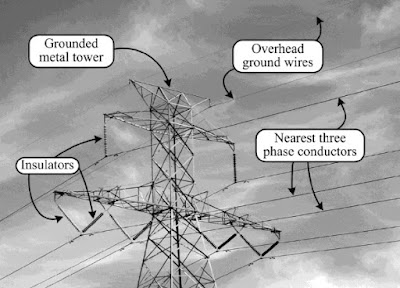Protection of Power Transmission Line from the effect of Lightening is achieved by using Sky Wire which is also known as Ground Wire or Shield Wire.
A picture of flashover between the phase conductors due to lightening is shown below.
Ground wires is a conductor running parallel to the Power Conductors of the Transmission Line and is placed at the top of the tower structure supporting the power conductors as shown in the very first figure. The conducting tower structure serves the purpose of down conductor to earth for Lightening Strikes.
Overhead Ground Wire is normally not used in Distribution Lines except for the region where the probabilities of Lightening Strikes are quite high. On Distribution Line down conductors are bare wire affixed to the wooden pole structure as shown in figure below.
While overhead ground wires are generally effective in providing protection for the phase conductors against the effects of lightning, they do exhibit two failure modes.
(1) Lightning current injected into an overhead ground wire can result in ‘‘back-flashover’’ from the ground wire to a phase wire if the resultant voltage on the ground wire is high enough, as can occur if there is the combination of a large lightning current and inadequate grounding of the overhead ground wire.
(2) Lightning may bypass an overhead ground wire and strike a phase wire directly if the overhead ground wire is not properly located, and sometimes even if it is.
The Shielding Angle is defined as the angle between an imaginary vertical line extending downward from the overhead ground wire and an imaginary line connecting the ground wire and phase conductor, as shown in figure below.
Shielding angles of about 30 degrees is used for majority of transmission lines with tower heights in the range of 25 m. Taller lines require smaller shielding angles than 30 degrees or else there will be Shielding Failures; that is, the lightning will bypass the overhead ground wire and strike the phase wire.
Protection zone of Ground Wire is a cone with apex at the location of Ground Wire and surface generated by line passing through the outermost phase conductor. If two or more Ground Wires are used then protection zone between two adjacent Ground Wires is a semicircle with diameter connection the two Ground Wires.
Thank you!




Knowledgeable article. I like it.
it was very helpful subject & i want more material regarding transmission lines
What technics and economics conditions to install ground wires in overhead electric lines up to 69 kV, as protection against lightning ?
Preliminaires thanks and best regards